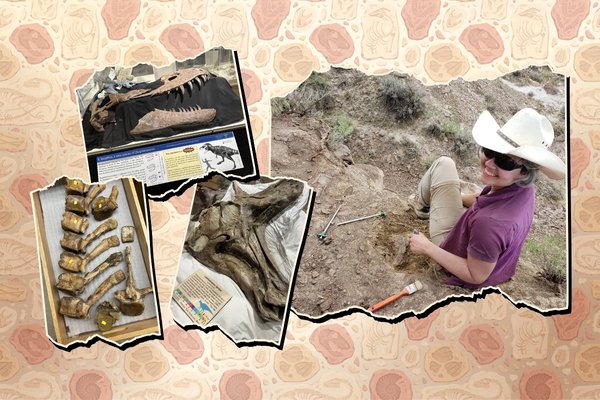If you can dig spending three months outdoors under the blistering sun, sleeping in tents and combing through the rugged landscape of Montana’s Judith River Formation on your hands and knees, then Dickinson State University assistant professor of biological and Earth sciences Dr. Liz Freedman Fowler has an offer for you.
Why not help her look for dinosaurs?
Each summer, Freedman Fowler and her husband (Badlands Dinosaur Museum director Dr. Denver Fowler) conduct a summer-long dinosaur dig looking for fossils in one of the top fossil sites in the world. And she invites anyone – amateur to professional – to come along.
“We’re doing more scientific research digs so we want long-term volunteers for a least three weeks from each person,” Freedman Fowler said. “We have volunteers from all over the world: England, France, Italy, Denmark, Canada. It’s a mix. Some are students studying paleontology. Others are all ages and walks of life: students, teachers, doctors, engineers. We had a lot of military people this summer.”
These serious dino diggers camp in tents without running water. They only recently added solar panels to charge devices like phones. Freedman stays out two and a half months; while Denver stays for three. Last year, a small tornado destroyed a tent but no one was injured.
Don’t come looking for leaves in rocks. The digs target the remains of dinosaurs like the duck-billed hadrosaur Lambeosaurus and the ancestor to T. rex, the Albertosaurus.
“Montana is one of the richest places in the world for dinosaur fossils,” Freedman Fowler said. “There is a little patch in North Dakota but most of the places like Theodore Roosevelt National Park are after the dinosaurs went extinct. Great fossils, but not dinosaurs.
“We study the evolution of dinosaurs. We’re focusing on the Judith River Formation. The most famous place in Montana is the Hell Creek Formation. That’s right when the dinosaurs went extinct 66 million years ago. We’re going back 10 million years older than that.”
Freedman Fowler came to Dickinson State seven years ago after a stint as executive director of St. George (Utah) Dinosaur Discovery Site after finishing her Ph.D. in earth sciences at Montana State. Denver was hired as curator at the Badlands Dinosaur Museum and she came with him. “I’m here because of dinosaurs,” she said with a laugh.
Freedman Fowler’s first Montana dig was as a student in 2001. She’s worked in the general area since then, and that’s not unusual for work in a “bone bed.”
“Most sites take more than one year, but if you are in a bone bed you can be digging that for decades. We might shift to new towns after five or 10 years. Whatever we find is what we’re going to research.”
Her current research includes studying evolution of duck-billed dinosaurs. Examples of her team’s work – she has run crews of six to 16 diggers each summer since 2004 – can be found at the Badlands Dinosaur Museum. Getting specimens from the field to the display is very time consuming. But, hey, compared to the 77 million years it took to find the bones, a decade or two is a drop in the bucket.
Her dig sites are ground zero for dinosaurs.
“Dinosaurs are in every continent and every country, but the western U.S. is one of the best places in the world and it has to do with the geology of the Cretaceous,” Freedman Fowler explained. “The Rocky Mountains were forming so you have mountains coming up to provide fresh rock to be eroded. On the east side of Rockies, you have a basin that catches the rocks eroding off the mountains. You have the space to bury (dinosaurs) and the fresh rock to bury them. At that point in time, it’s great for preserving fossils. Geology just east of the Rockies is perfect.”
While fieldwork is a big part of Freedman Fowler’s work, studying what she finds is just as important. “I consider myself more of a biologist. The biological side is fascinating. To study, you need a good sample size. You can look at how they grow up and how they were evolving over time.”
Recent dino digs near Havre and Glasgow, Montana, unearthed an almost complete Lambeosaurus, a dinosaur with a crest along the top of its head. “We found basically a complete one, the first found in the United States, and it’s got skin all over it. We have most of it collected and now it has to be cleaned, especially the skin. It’s cool and exciting and logistically annoying.”
Freedman Fowler’s team has also found crocodiles, turtles and the Champsosaurus. “That’s interesting because there are a lot of them in the Cretaceous with the dinosaurs and then all the dinosaurs go extinct at the KT boundary,” she explained. “But Champsosaurus makes it through, then 10 million years later, poof, gone.”
Presumably changes in the climate, moisture and changing temperatures in what used to be a seashore environment caused them to go extinct. The KT boundary refers to the meteor strike that led to the extinction of the dinosaurs 66 million years ago.
“The end was the meteor, but they were in decline before that. The climate was changing and ecosystems were changing. It was a tough time for dinosaurs already. When the meteor came it was the final straw for them,” Freedman Fowler said.
Dickinson State recognized Freedman Fowler last spring with its Professional Contributions Award. Her work may also lead indirectly to expansion of the Badlands Dinosaur Museum. Discussions are ongoing to increase displays from her digs, which will continue next summer.
Anyone interested in boning up on dinosaurs can join a dig. Contact Freedman Fowler by email at Elizabeth.freedman@dickinsonstate.edu. Last year’s dig crew was filled by February.
But beware: “Sometimes it’s 110 (degrees),” Freedman Fowler said. “It’s very strenuous, very hard work, but it’s fun.”
By: Scooter Pursley, DSU Heritage Foundation Communication Specialist

